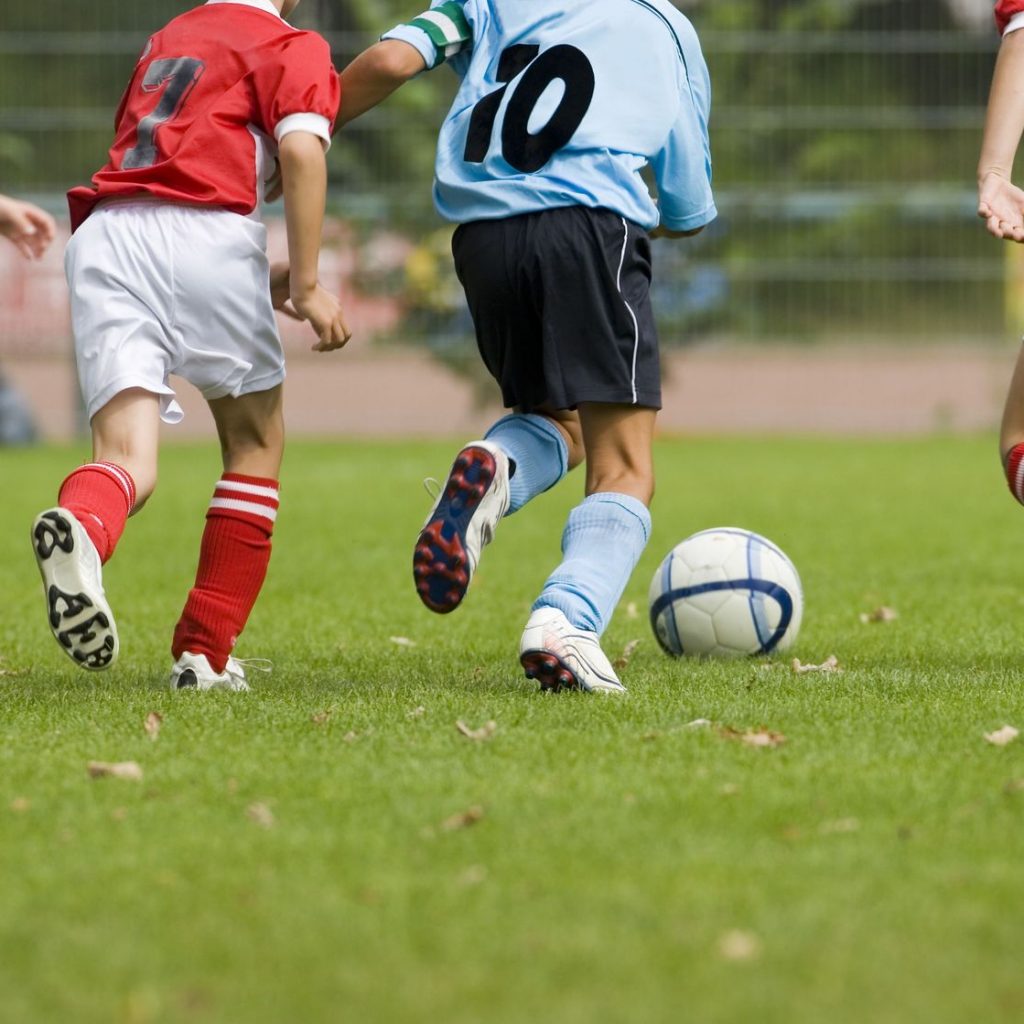Leslie Solomonian, ND
Benefits of Physical Activity
Physical activity has wide-reaching benefits for children, including improving body composition, academic performance, self-esteem, and bone mass. Physical activity in childhood predicts physical activity in adulthood and reduces the lifetime risk of non-communicable chronic diseases, including cancer and cardiovascular disease, the most significant causes of morbidity and mortality in North America. If anything is a panacea for therapeutic and preventative purposes, it is exercise. However, North American children and youth routinely fail to meet the minimum recommendation of
60 minutes of moderate-vigorous physical activity (MVPA) per day,1,2 placing them at risk of suboptimal health in childhood and as they become adults. Barriers to activity include lack of enjoyment, positive role models, or safe outdoor spaces, and competition with sedentary activities such as television-watching and video games. Naturopathic doctors can be part of a multi-tiered approach to promote physical activity among children and youth.
Both sedentary behavior and overweight/obesity negatively impact cognition and academic performance.3 A 2013 systematic review of randomized controlled trials demonstrated a positive (albeit small) correlation between acute aerobic physical activity and some domains of cognitive function in children.4 A number of other studies have shown positive correlations between physical fitness and cognition as well as academic performance, underscoring the value of incorporating physical activity throughout the school day.3-6
Engagement in physical activity may improve self-esteem via a number of mechanisms. Children who are less active are more likely to be obese or overweight, which can cause them to experience higher rates of depression and low self-esteem, particularly with respect to athletic aptitude, physical appearance, disordered eating, and peer interactions and bullying.7,8 MVPA and participation in sports have been demonstrated to reduce rates of depression in children and youth.9 Participation in organized sports may improve social functioning, including higher self-esteem, problem-solving capacity, reduced substance use, and reduced depression and anxiety.6 The psychosocial benefit of physical activity on cognition, academic performance, and psychosocial health in youth may be dose-dependent.6
Weight-bearing, high-impact physical activity plays a critical role in the acquisition of bone mass during adolescence.9,10 A 2013 study found an association between measures of muscle strength and bone mass density in youth aged 11-16 years.11 The study also noted an inverse correlation between body fat percentage and bone density parameters, suggesting a multi-mechanistic role for the benefit of physical activity on bone health. A more recent systematic review confirmed a positive relationship between bone mass density and body composition, as well as between bone health and levels of physical activity directly.12 The studies reviewed were interventional trials, suggesting a causative relationship. Peak bone mass predicts adult bone mass; thus, encouraging high-impact physical activity during the pre- and peri-pubescent years may have lifelong benefits.9,13
Although the causes of obesity are complex and individual, both physical fitness and activity are associated with lower rates of obesity and its comorbidities in children and youth.14 Interventional trials have demonstrated improvements in body composition parameters in youth, subsequent to physical activity interventions.9 Associated with overweight and obesity, a range of studies has demonstrated a positive effect of physical activity on markers of cardiovascular and metabolic disease in youth, including cholesterol profile, insulin sensitivity, and systolic blood pressure.9,15
There is some evidence that both acute and ongoing physical activity impacts the functioning of the immune system in children.16 Regular physical activity in children may have a positive effect on atopy and allergy vulnerability, and may reduce the risk of developing cancer over the lifespan.17,18 Physical activity may be beneficial, not only in promoting health in children, but also in addressing medical concerns including ADHD,19 cystic fibrosis,20 asthma,21 inflammatory bowel disease,22 and childhood cancers.23-25 The exact nature of optimal recommended activity remains to be determined for prevention and management of inflammatory conditions.16
The exact associations between sleep quantity and daytime MVPA (and their associated impacts on body composition) are not clear.26,27 Results from a systematic review suggested that children who engaged in higher levels of MVPA ultimately slept less.26 Other sources suggest that regularity of sleep patterns are associated with increased physical activity.27 An active child may sleep more because he or she requires the rest; a child with insufficient sleep may not have the energy to engage in MVPA; a child who naturally has more energy may innately engage in MVPA and need less sleep. Reciprocity and causation are unclear.
Regular engagement in physical activity may reduce the risk of musculoskeletal tension and pain,28 and appears to be inversely correlated with functional constipation in childhood.29
Risks of Physical Activity in Youth
Physical injuries occur more frequently in children engaged in physical activity, particularly concussive injuries30,31 and trauma to the extremities.32 Immaturity of the musculoskeletal system30,33 and activities involving body contact and requiring excessive flexibility may increase the risk of specific traumatic mechanisms. Establishing a baseline of physical fitness and ensuring appropriate technique, equipment, and coaching can reduce the risk of these injuries.34,35 Effective rest, rehabilitation, and recovery is critical for all athletes.
Some studies have demonstrated that youth involved in sport specifically may have higher levels of negative peer-interactions.6 This may be attributed to the inherent competition in sport, which may ultimately increase resilience and problem-solving capacity in young people. The pressure from parents, coaches and peers to perform and specialize at a young age can create stress and loss of enjoyment for young athletes, possibly leading to attrition.35 Considering that most children will not achieve professional levels of athletic competition, physical activity for the purposes of promoting health and wellness, emphasizing fun, sportsmanship, and safe physical activity may be the most successful strategies for encouraging lifelong physical fitness.
Recommendations for Physical Activity
In Canada, guidelines are developed by the Canadian Society for Exercise Physiology and adopted by the Public Health Agency of Canada.36,37 Guidelines in the United States are developed by the Physical Activity Guidelines Advisory Committee and ratified by the Secretary of Health and Human Services.38 Current recommendations are summarized and compared in Table 1. The benefits of physical activity appear to have a dose-response relationship; in general, more frequent, greater duration, and more vigorous and weight-bearing physical activities yield the most health benefits. For the greatest likelihood of sustainability, activities should be fun, varied, and balanced with appropriate recovery factors (adequate nutrition and rest), with minimal risk for injury. Minimum levels of activity can be achieved through organized sport, unstructured play, and routine household chores and active transportation. A table of suggested activities at varying levels of intensity is provided in the 2008 Physical Activity Guidelines for Americans.38
Despite these clear recommendations, children in North America are failing to achieve even minimum levels of physical activity.1 The most recent Canadian Health Measures Survey revealed that only 7% of Canadian children and youth accumulate at least 60 minutes of moderate to vigorous physical activity at least 6 days a week. Only one-quarter of children manage to accumulate
30 minutes of activity 6 days per week.2
Barriers and Strategies to Increase Physical Activity
Because of limited independent mobility, most children divide most of their waking time between home and school; thus, school and home-based interventions may be the most beneficial approaches to increasing physical activity among children and youth. A Cochrane review of the value of school-based interventions suggests a small but significant improvement in rates of physical activity, if not a clear beneficial outcome in terms of health parameters.39
Parents play a critical role in the home through role-modeling and support for engagement in physical activity. Parental lack of education and poor modeling directly correlate with low levels of physical activity, particularly in families of lower socioeconomic status and in children with a disability.40,41 The degree of sedentary behavior engaged in by the parent is a strong predictor of sedentary behavior in the child.42 Access to electronic media equipment in the home appears to reduce engagement in physical activity, particularly if devices are permitted in a child’s room.41,42 Lack of access to athletic facilities and equipment may reduce the likelihood that a child will engage in physical activity. Restrictions on active transport (such as walking or cycling to school or friends’ homes) are also inversely correlated with physical activity in children.43
In one review, giving children the opportunity to play in their local neighborhood seemed to have the most significant impact.43 Parents who engage in physical activity on their own and with their children are more likely to raise children who are physically active.44 Emphasizing fun and safety in sport and physical activity is likely to prompt longer participation in children. Access to physical activity equipment in the home, and limitations on time that children spend engaged in sedentary, screen-based activities seem to increase physical activity rates.42
Active transportation, to school and elsewhere, has been positively correlated to physical activity and body composition in children and youth.1,45,46 Encouraging children to play outside and actively transport yields the added benefits of promoting independence, developing social skills and reducing emissions, and communicates values that are transferrable through the lifespan.45 The author wonders if the association may be correlative as opposed to causative, as the amount of time and intensity the typical child spends in active transport is likely less than the recommendations for daily MVPA. However, a family culture in which active transport is encouraged is likely also one that values and encourages physical activity, in general. Of course, the design of the community must be conducive to safe outdoor play and active transport. Investment in effective community design can have tremendous impact on the physical activity and fitness of community members.47
Conclusions and Future Directions
Physical activity is a lifestyle behavior that has benefits both deep and wide. Unfortunately, North American children and youth are not achieving even minimum levels. As with all health promotion, the naturopathic doctor can play a number of roles, addressing the issue at multiple levels. Taking the time to inquire about physical activity rates in pediatric patients, and educating caregivers on the benefits, risks, and recommendations for physical activity may be valuable strategies to address key barriers. Identifying activities that the entire family can enjoy together, including active transportation, can increase physical activity in all family members while promoting connection and enhancing relationships. Encouraging caregivers to support their children in participating in organized sport (through school or extra-curricular) and/or lifestyle activities and active play can set the stage for lifelong benefits, both behavioral and health-related. Advising caregivers to limit the time all family members spend engaged in sedentary activities is critical, particularly using electronic digital media; removing digital media from children’s rooms may improve rates of physical activity, as well as media safety and literacy. Engaging in community advocacy at the school or government level to promote affordable, safe access to playgrounds, community centers, competitive and recreational sport opportunities, and active transportation routes can address a higher tier of intervention.
References: Leslie Solomonian, ND, is a naturopathic doctor in Toronto and assistant professor at the Canadian College of Naturopathic Medicine. She provides instruction in pediatrics, philosophy, and clinical medicine, and supervises medical interns at the Robert Schad Naturopathic Clinic. Leslie has a strong interest in health promotion, knowing that wellness is more than just the absence of disease. Health of the individual child is affected by the well-being of the family, the community, and the environment. As such, Leslie is leading a team at CCNM in developing and evaluating the feasibility of a group-based approach to promoting wellness behaviors in young families.
Leslie Solomonian, ND, is a naturopathic doctor in Toronto and assistant professor at the Canadian College of Naturopathic Medicine. She provides instruction in pediatrics, philosophy, and clinical medicine, and supervises medical interns at the Robert Schad Naturopathic Clinic. Leslie has a strong interest in health promotion, knowing that wellness is more than just the absence of disease. Health of the individual child is affected by the well-being of the family, the community, and the environment. As such, Leslie is leading a team at CCNM in developing and evaluating the feasibility of a group-based approach to promoting wellness behaviors in young families.
References
- Are We Driving Our Kids to Unhealthy Habits? The 2013 Active Healthy Kids Canada Report Card on Physical Activity for Children and Youth. Active Healthy Kids Canada Web site. http://www.activehealthykids.ca/2013ReportCard/en/. Accessed May 5, 2014.
- Colley RC, Garriguet D, Janssen I, et al. Physical activity of Canadian children and youth: accelerometer results from the 2007 to 2009 Canadian Health Measures Survey. Health Rep. 2011;22(1):15-23.
- Burkhalter TM, Hillman CH. A narrative review of physical activity, nutrition, and obesity to cognition and scholastic performance across the human lifespan. Adv Nutr. 2011;2(2):201S-206S.
- Lees C, Hopkins J. Effect of aerobic exercise on cognition, academic achievement, and psychosocial function in children: a systematic review of randomized control trials. Prev Chronic Dis. 2013;10:E174.
- Drollette ES, Scudder MR, Raine LB, et al.Acute exercise facilitates brain function and cognition in children who need it most: an ERP study of individual differences in inhibitory control capacity. Dev Cogn Neurosci. 2014;7:53-64.
- Eime RM, Young JA, Harvey JT, et al. A systematic review of the psychological and social benefits of participation in sport for children and adolescents: informing development of a conceptual model of health through sport. Int J Behav Nutr Phys Act. 2013;10:98.
- Danielsen YS, Stormark KM, Nordhus IH, et al. Factors associated with low self-esteem in children with overweight. Obes Facts. 2012;5(5):722-733.
- Nieman P, Leblanc CM, Canadian Paediatric Society, Healthy Active Living and Sports Medicine Committee. Psychosocial aspects of child and adolescent obesity: Position statement of the CPS. Paediatr Child Health. 2012;17(4):205-208.
- Janssen I, Leblanc AG. Systematic review of the health benefits of physical activity and fitness in school-aged children and youth. Int J Behav Nutr Phys Act. 2010;7:40.
- Gunter KB, Almstedt HC,Janz KF. Physical activity in childhood may be the key to optimizing lifespan skeletal health. Exerc Sport SciRev. 2012;40(1):13-21.
- de Moraes AM, Gonçalves EM, de Oliveira Barbeta VJ, Guerra-Júnior G. A cross-sectional study of the association of body composition and physical fitness with bone status in children and adolescents from 11 to 16 years old. BMC Pediatrics. 2013;13(1):117.
- Tan VP, Macdonald HM, Kim S, et al. Influence of Physical Activity on Bone Strength in Children and Adolescents: A Systematic Review and Narrative Synthesis. J Bone Miner Res. 2014 Apr 16. [Epub ahead of print]
- Warden SJ, Mantila Roosa SM, Kersh ME, et al. Physical activity when young provides lifelong benefits to cortical bone size and strength in men. Proc Natl Acad Sci U S A. 2014;111(14):5337-5342.
- Rauner A, Mess F, Woll A. The relationship between physical activity, physical fitness and overweight in adolescents: a systematic review of studies published in or after 2000. BMC Pediatr. 2013;13:19.
- Verona J, Gilligan LE, Giménez C, et al. Physical activity and cardiometabolic risk in male children and adolescents: the Balcarce study. Life Sci. 2013;93(2-3):64-68.
- Ploeger HE, Takken T, de Greef MH, Timmons BW. The effects of acute and chronic exercise on inflammatory markers in children and adults with a chronic inflammatory disease: a systematic review. Exerc Immunol Rev. 2009;15:6-41.
- Prescott SL. Early-life environmental determinants of allergic diseases and the wider pandemic of inflammatory noncommunicable diseases. J Allergy Clin Immunol. 2013;131(1):23-30.
- Rogers CJ, Colbert LH, Greiner JW, et al. Physical activity and cancer prevention: pathways and targets for intervention. Sports Med. 2008;38(4):271-296.
- Wigal SB, Emmerson N, Gehricke JG, Galassetti P. Exercise: applications to childhood ADHD. J Atten Disord. 2013;17(4):279-290.
- Wilkes DL, Schneiderman JE, Nguyen T, et al. Exercise and physical activity in children with cystic fibrosis. Paediatr Respir Rev. 2009;10(3):105-109.
- Eijkemans M, Mommers M, Draaisma JM, et al. Physical activity and asthma: a systematic review and meta-analysis. PLoS One. 2012;7(12):e50775.
- Ploeger H, Obeid J, Nguyen T, et al. Exercise and inflammation in pediatric Crohn’s disease. Int J Sports Med. 2012;33(8):671-679.
- Braam KI, van der Torre P, Takken T, et al. Physical exercise training interventions for children and young adults during and after treatment for childhood cancer. Cochrane Database Syst Rev. 2013;4:CD008796.
- Baumann FT, Bloch W, Beulertz J. Clinical exercise interventions in pediatric oncology: a systematic review. Pediatr Res. 2013 Oct;74(4):366-374.
- Kruijsen-Jaarsma M, Révész D, Bierings MB, et al. Effects of exercise on immune function in patients with cancer: a systematic review. Exerc Immunol Rev. 2013;19:120-143.
- Williams SM, Farmer VL, Taylor BJ, Taylor RW. Do more active children sleep more? A repeated cross-sectional analysis using accelerometry. PLoS One. 2014;9(4):e93117.
- Stone MR, Stevens D, Faulkner GE. Maintaining recommended sleep throughout the week is associated with increased physical activity in children. Prev Med. 2013;56(2):112-117.
- Myrtveit SM, Sivertsen B, Skogen JC, et al. Adolescent Neck and Shoulder Pain-The Association With Depression, Physical Activity, Screen-Based Activities, and Use of Health Care Services. J Adolesc Health. 2014 Apr 16. [Epub ahead of print]
- Driessen LM, Jong Kiefte-de JC, Wijtzes A, et al. Preschool physical activity and functional constipation: the Generation R study. J Pediatr Gastroenterol Nutr. 2013;57(6):768-774.
- Adirim TA, Cheng TL. Overview of injuries in the young athlete. Sports Med. 2003;33(1):75-81.
- Guerriero RM, Proctor MR, Mannix R, Meehan WP. Epidemiology, trends, assessment and management of sport-related concussion in United States high schools. Curr Opin Pediatr. 2012;24(6):696-701.
- Jespersen E, Rexen CT, Franz C, et al. Musculoskeletal extremity injuries in a cohort of schoolchildren aged 6-12: A 2.5-year prospective study. Scand J Med Sci Sports. 2014 Jan 29. [Epub ahead of print]
- Hennrikus W, Pylawka T. Patellofemoral instability in skeletally immature athletes. J Bone Joint Surg Am. 2013;95(2):176-183.
- Carter CW, Micheli LJ. Training the child athlete: physical fitness, health and injury. Br J Sports Med. 2011;45(11):880-885.
- Merkel DL. Youth sport: positive and negative impact on young athletes.Open Access J Sports Med. 2013;4:151-160.
- Canadian Physical Activity Guidelines and Canadian Sedentary Behaviour Guidelines. Canadian Society for Exercise Physiology Web site. www.csep.ca/guidelines. Accessed May 6, 2014.
- Physical Activity Guidelines. Public Health Agency of Canada Web site. http://www.phac-aspc.gc.ca/hp-ps/hl-mvs/pa-ap/03paap-eng.php. Accessed May 6, 2014.
- 2008 Physical Activity Guidelines for Americans. Office of Disease Prevention and Health Promotion Web site. http://www.health.gov/paguidelines/guidelines/. Accessed May 6, 2014.
- Dobbins M, Husson H, DeCorby K, LaRocca RL. School-based physical activity programs for promoting physical activity and fitness in children and adolescents aged 6 to 18. Cochrane Database Syst Rev. 2013;2:CD007651.
- Shields N, Synnot AJ, Barr M. Perceived barriers and facilitators to physical activity for children with disability: a systematic review. Br J Sports Med. 2012;46(14):989-997.
- Tandon PS, Zhou C, Sallis JF, et al. Home environment relationships with children’s physical activity, sedentary time, and screen time by socioeconomic status. Int J Behav Nutr Phys Act. 2012;9:88.
- Maitland C, Stratton G, Foster S, et al. A place for play? The influence of the home physical environment on children’s physical activity and sedentary behaviour. Int J Behav Nutr Phys Act. 2013;10:99.
- McMinn AM, Griffin SJ, Jones AP, van Sluijs EM. Family and home influences on children’s after-school and weekend physical activity. Eur J Public Health. 2013;23(5):805-810.
- Fuemmeler BF, Anderson CB, Mâsse LC. Parent-child relationship of directly measured physical activity. Int J Behav Nutr Phys Act. 2011;8:17.
- Carver A, Timperio AF, Kesketh KD, et al. How is active transport associated with children’s and adolescents’ physical activity over time? Int J Behav Nutr Phys Act. 2011;8:126.
- Lubans DR, Boreham CA, Kelly P, Foster CE. The relationship between active travel to school and health-related fitness in children and adolescents: a systematic review. IntJ Behav Nutr Phys Act. 2011;8:5.
- Fenton M. Community design and policies for free-range children: creating environments that support routine physical activity. Child Obes. 2012; 8(1):44-51.





